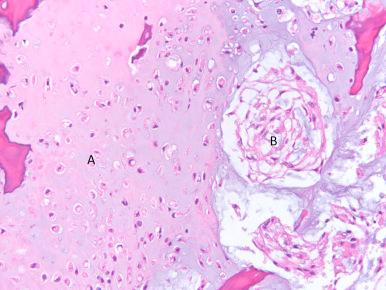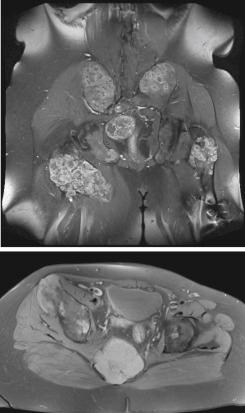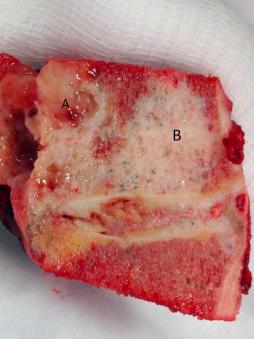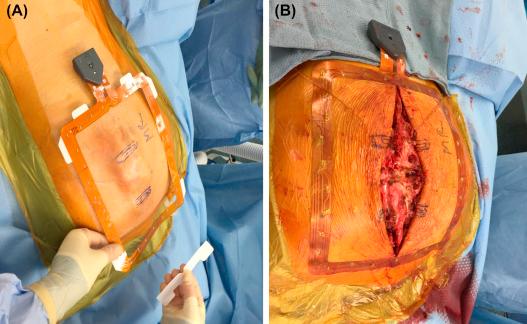Physical Address
304 North Cardinal St.
Dorchester Center, MA 02124
© 2018 Elsevier Inc. All rights reserved. Please note that the copyright for the original figures submitted by the contributors is owned by Contributors.
Chordoma and chondrosarcoma are closely related malignant tumors; in fact, a subtype of chordoma, chondroid chordoma, contains cartilage ( Fig. 39.1 ). The etiology of malignant cartilage tumors has been more thoroughly investigated than that of chordoma. In some hereditary tumor conditions of cartilage, such as hereditary multiple osteocartilaginous exostosis (HMOCE), genetic modifications have been identified in the EXT genes. Although some patients with HMOCE also have a chordoma ( Fig. 39.2 ), the benign exostotic tumor or osteochondroma in HMOCE is more likely to undergo malignant transformation to chondrosarcoma. In HMOCE and other conditions, enostotic cartilage tumors (inside bone) become malignant more frequently than do exostotic tumors (on the bone surface). Tumors in patients with either Ollier’s or Maffucci’s syndrome have a much higher rate of malignant transformation than those in HMOCE; the rate is highest in Mafucci’s syndrome. Maffucci’s syndrome includes vascular tumors of soft tissues as well as multiple enostotic cartilage tumors, but Ollier’s syndrome does not.


Chordomas are thought to arise from benign notochordal cell tumors (BNCTs), identified in about 20% of cadavers at autopsy. These benign tumors of notochordal cell rests can transform into a chordoma just as an enchondroma can transform into a chondrosarcoma. In some cases, there is no histologic separation between the chordoma tissue and notochordal cell rests ( Fig. 39.3 ). The precise mechanisms of these transformations from benign to malignant are unknown.

Almost all chordomas stain for T-brachyury. Comparative genomic hybridization (CGH) has identified unique duplications of chromosome 6q27, which contains the T-brachyury gene, in four families with chordomas. T-brachyury is a transcription factor that promotes cell movement and adhesion, which are fundamental to both morphogenesis and tumorigenesis. In sporadic cases of chordoma, although this duplication of T-brachyury has not been found, the T-brachyury transcript is highly expressed, and it is an excellent marker for the disease. T-brachyury has been detected in both the chondroid and chordoid components of chordomas, suggesting that both arise from the notochord. Thus T-brachyury links the notochord to cartilage as well as to chordoma.
T-brachyury has become a target for immunotherapy, but, thus far, clinical trials have met with little success. However, preclinical studies showing that a recombinant Saccharomyces cerevisiae (yeast) vaccine encoding brachyury activated human T-cells in vitro is both safe and immunogenic have prompted a randomized phase-II clinical trial.
In general chordomas and chondrosarcoma may share mechanisms of origin. These include derivation from cancer stem cells. Both tumors can dedifferentiate into a variant containing a high-grade sarcomatous component.
Chordoma and chondrosarcoma both have abundant extracellular matrix (ECM) with overexpression of numerous genes, including aggrecan, type-II and X collagen, fibronectin, matrillin 3, CSPG4, matrix metalloproteinase MMP-9, and MMP-19. As this extracellular matrix provides a barrier to delivery of oxygen and chemotherapeutics, breaking down these matrix proteins may improve tumor responsiveness to radiation, by improving tumor cell oxygenation, and to chemotherapy, by increasing drug penetration to tumor cells; matrix proteins may also serve as targets for immunotherapy. Conjugation of melphalan (Mel) to quaternary ammonium (QA), which targets the complex to proteoglycan (PG)-rich tissues, may improve its therapeutic index.
Surgery remains the mainstay of treatment for both chordoma and chondrosarcoma. New techniques may improve extent of resection and thus local control. Intraoperative adjuvants such as cryotherapy may decrease local recurrence. Staged approaches and aortic balloon pump, both of which can reduce blood loss, may improve outcomes. Guidelines for their management are located in the NCCN Guidelines Version 2.2017 Bone Cancer chapter. Although staged resections have become more common—data from the Mayo Clinic have demonstrated improved outcomes, better resource management, and decreased hospital costs with staged approaches for chordoma —there is renewed enthusiasm for posterior-only approaches to spine tumors, aided by intraoperative navigation with real-time imaging ( Fig. 39.4 ). Control of the iliac vessels and their branches is better with a two-stage approach than with a posterior-only approach, but the greater blood loss of posterior-only approaches may be diminished by an aortic balloon pump. Increased use of vascularized flaps of rectus abdominus, gluteus maximus, or hamstring muscle to repair soft-tissue defects created by exposure and resection of spine chordoma has improved postoperative outcomes.

Minimally invasive surgical techniques, including heat ablation and cryotherapy are being tested for benign and malignant bone tumors. Heat ablation has limited applicability to chordomas and condrosarcomas because their gelatinous, myxoid matrix excessively absorbs heat. Cryotherapy, however, has more potential. It can be applied to solid tumor thorough a probe, either before or instead of surgery, or by incubating the tumor’s resection cavity in liquid nitrogen. Use of this approach should consider the affected site, local tumor extension, feasibility of surgery, and clinicopathologic tumor grade. Critically evaluating patients’ quality of life (QOL) after all treatments is extremely important and is becoming routine.
Become a Clinical Tree membership for Full access and enjoy Unlimited articles
If you are a member. Log in here